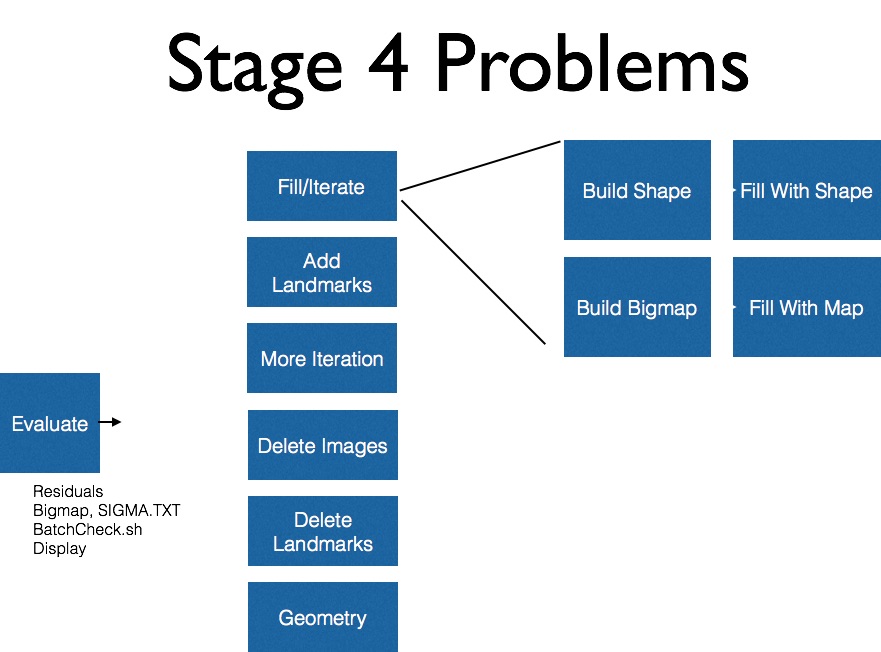|
Size: 67
Comment:
|
Size: 2028
Comment:
|
| Deletions are marked like this. | Additions are marked like this. |
| Line 1: | Line 1: |
| Describe Fixing_problem_landmarks here. | = Fixing Landmarks = |
| Line 4: | Line 4: |
| [[file:problem.jpg]] | Image of thing to try: {{attachment:problem.jpg||width=400}} === When to Fix Landmarks === At the end of each tiling or iteration, a form of find_nofit (T or P) is used to check for bad landmarks. A common find_nofit output will look soemthing like this: {{{ EQ0004: cat 004.OOT EP0002: cat 005.OOT EP0003: cat 006.OOT EO0003: cat 007.OOT EN0003: * cat 008.OOT EN0004: * cat 009.OOT EM0003: . cat 010.OOT EM0004: * cat 011.OOT 132 deleted ! cat 132.OOTThe }}} The Four main types of find_nofit outputs are: * ! - the landmark was deleted * . - the landmark has overlaps * (space) - the landmark has minor error (don't worry about it). * * - the landmark has a major error and must be fixed. All errors are worth recording, but the only output from find_nofit that warrants serious concern is *. Whenever a * is present in the find_nofit output the landmark that * is associated with must be fixed. To fix bad land marks [[lithos.e|lithos]] is used in the working directory. === How to Fix Landmarks === Once a problem landmark is identified, the executable [[lithos.e|lithos]] can be entered in the working directory to fix the landmark. The steps to do this are as follows: 1. The first major step in fixing a bad landmark is to select that landmark within [[lithos.e|lithos]]. As an example, the landmark EM0004 in the find_nofit output above has major errors. To select this landmark the following commands are entered in the [[lithos.e|lithos]] executable: {{{ i EM0004 n n }}} The output of these commands looks like this: {{{ Current landmark = NONE Main Menu: Q 0123O IUCRSG NVAMBX DEPL FZH? i >i Input 6-character landmark name.[Q] EM0004 -0.31014 0.47683 -0.31113 0.29307 gc slope.pgm Check for more images? y[n] n Include a single image? y[n] n }}} With the landmark now selected |
Fixing Landmarks
Image of thing to try:

When to Fix Landmarks
At the end of each tiling or iteration, a form of find_nofit (T or P) is used to check for bad landmarks.
A common find_nofit output will look soemthing like this:
EQ0004: cat 004.OOT EP0002: cat 005.OOT EP0003: cat 006.OOT EO0003: cat 007.OOT EN0003: * cat 008.OOT EN0004: * cat 009.OOT EM0003: . cat 010.OOT EM0004: * cat 011.OOT 132 deleted ! cat 132.OOTThe
The Four main types of find_nofit outputs are:
- ! - the landmark was deleted
- . - the landmark has overlaps
- (space) - the landmark has minor error (don't worry about it).
- * - the landmark has a major error and must be fixed.
All errors are worth recording, but the only output from find_nofit that warrants serious concern is *. Whenever a * is present in the find_nofit output the landmark that * is associated with must be fixed. To fix bad land marks lithos is used in the working directory.
How to Fix Landmarks
Once a problem landmark is identified, the executable lithos can be entered in the working directory to fix the landmark. The steps to do this are as follows:
1. The first major step in fixing a bad landmark is to select that landmark within lithos. As an example, the landmark EM0004 in the find_nofit output above has major errors. To select this landmark the following commands are entered in the lithos executable:
i EM0004 n n
The output of these commands looks like this:
Current landmark = NONE
Main Menu: Q 0123O IUCRSG NVAMBX DEPL FZH? i
>i
Input 6-character landmark name.[Q]
EM0004
-0.31014 0.47683 -0.31113 0.29307
gc slope.pgm
Check for more images? y[n]
n
Include a single image? y[n]
nWith the landmark now selected
